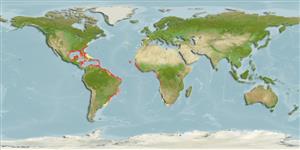Common names from other countries
Cephalopoda |
Octopoda |
Octopodidae
Environment: milieu / climate zone / depth range / distribution range
Ecology
Benthic; depth range 0 - 200 m (Ref. 104052). Tropical
Atlantic Ocean.
Length at first maturity / Size / Weight / Age
Maturity: Lm ? range ? - ? cm Max length : 7.0 cm ML male/unsexed; (Ref. 104052); 6.6 cm ML (female)
Maximum total length is 25 cm (Ref. 96968). This is a benthic species found in sandy and muddy bottoms in subtidal areas (Ref. 83938).
Life cycle and mating behavior
Maturity | Reproduction | Spawning | Eggs | Fecundity | Larvae
Members of the class Cephalopoda are gonochoric. Male and female adults usually die shortly after spawning and brooding, respectively. Mating behavior: Males perform various displays to attract potential females for copulation. During copulation, male grasp the female and inserts the hectocotylus into the female's mantle cavity where fertilization usually occurs. Life cycle: Embryos hatch into planktonic stage and live for some time before they grow larger and take up a benthic existence as adults.
Hochberg, F.G. and Y.E. Camacho-García. 2009. (Ref. 83938)
IUCN Red List Status
(Ref. 130435: Version 2025-1)
CITES status (Ref. 108899)
Not Evaluated
Not Evaluated
Threat to humans
Harmless
Human uses
Fisheries: bycatch
| FishSource |
Tools
More information
Trophic EcologyFood items (preys)
Diet composition
Food consumption
Predators
Population dynamicsGrowthMax. ages / sizesLength-weight rel.Length-length rel.Length-frequenciesMass conversionAbundance Life cycleReproductionMaturityFecunditySpawningEggsEgg developmentLarvae PhysiologyOxygen consumption
Human RelatedStamps, coins, misc.
Internet sources
Estimates based on models
Preferred temperature
(Ref.
115969): 21.1 - 27.5, mean 25.2 (based on 80 cells).
Fishing Vulnerability
Low vulnerability (10 of 100).
